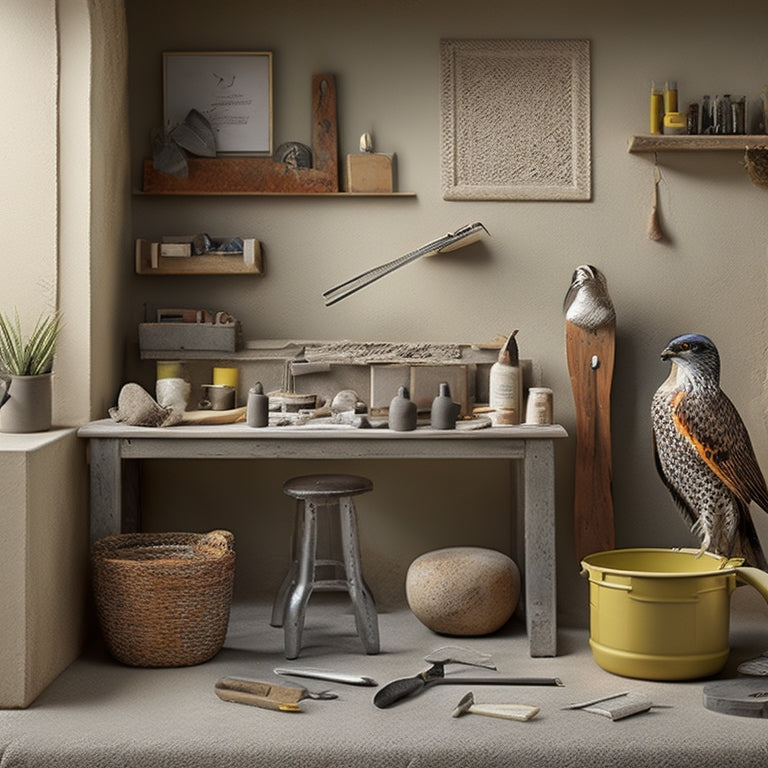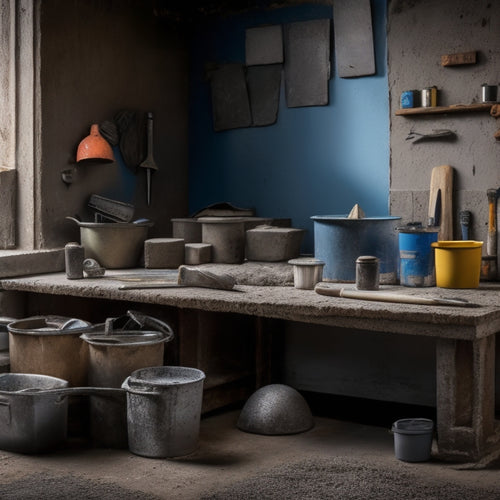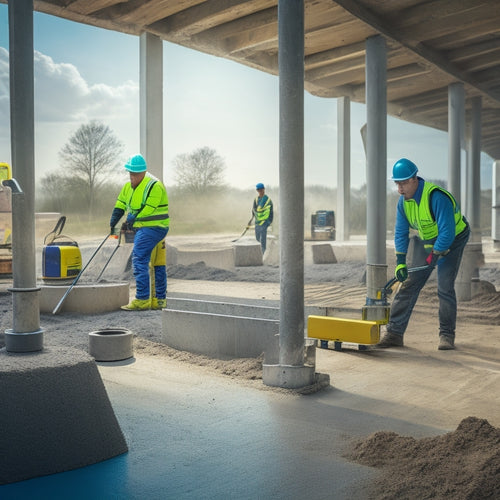
Why Choose These Stucco Finishing Tools for Concrete
Share
You're investing time and effort into a stucco project, and the right finishing tools can make all the difference between a mediocre and exceptional outcome. By choosing these stucco finishing tools for concrete, you'll guarantee a smooth, uniform finish that meets high standards. From mixing and applying the stucco mixture to perfecting the scratch coat layer and achieving uniform base coats, each tool is designed for precision and control. With the right tools, you'll be able to excel at texture control, float finish technique, and advanced finishing techniques, ultimately elevating the aesthetic appeal of your project. Now, take a closer look at each tool to uncover how they can help you achieve perfection.
Key Takeaways
- These stucco finishing tools are designed specifically for concrete, ensuring a strong bond and uniform finish.
- The tools provide superior control over texture and pattern, allowing for precise application and customization.
- They enable the creation of a smooth, even base coat, which is essential for a high-quality stucco finish.
- The tools facilitate efficient removal of excess material and imperfections, resulting in a professional-looking finish.
- They are durable and long-lasting, reducing the need for frequent replacements and minimizing costs.
Essential Tools for Smooth Finish
Get hands-on with your stucco finishing project by gathering the essential tools for a smooth finish.
You'll need a variety of tools to guarantee a professional-looking stucco application. Start with a sturdy mixing stick to combine your stucco mixture, and a hawk to hold and transport it to the application area.
A trowel is a must-have for applying and smoothing out the stucco, while a finishing trowel with a curved edge helps to create a smooth, even surface. Don't forget a level to verify your stucco is applied straight, and a joint knife to fill and finish joints.
For added texture and detail, incorporate a texture mat or finishing float into your finishing techniques.
Finally, a clean water source and a soft-bristled brush are necessary for cleaning and smoothing out the stucco.
With these tools at your disposal, you'll be well on your way to achieving a smooth, professional-looking stucco finish.
Perfecting the Scratch Coat Layer
With your arsenal of stucco finishing tools at the ready, you're now prepared to focus on the foundation of a successful stucco application: the scratch coat layer. This initial layer sets the stage for a durable, long-lasting finish, so it's vital to get it right. Aim for a layer thickness of 1/8 inch to 1/4 inch, as this allows for ideal bonding with the subsequent base coat.
To achieve a uniform scratch coat, use a notched trowel to spread the stucco mixture evenly, holding the trowel at a 45-degree angle. This guarantees the mixture is pressed firmly into the substrate, creating a strong bond.
Use a level to check for any deviations in the layer, making adjustments as needed. It's important to work in small sections, about 10 feet by 10 feet, to maintain control and avoid unevenness.
As you work, use a scratching tool to create a series of shallow grooves, which will provide a mechanical bond for the next layer. By following these steps, you'll create a solid foundation for your stucco application.
Achieving Uniform Base Coats
You'll achieve a uniform base coat by mastering consistent application methods, ensuring that your stucco is applied at the right thickness and with the correct amount of pressure.
To get a smooth finish, you'll need to use techniques that eliminate air pockets and excess material, resulting in a surface that's even and free of imperfections.
Consistent Application Methods
Achieving uniform base coats relies on mastering a few key consistent application techniques.
You'll want to start by guaranteeing proper surface preparation, which includes cleaning the substrate to remove dirt, oil, or other contaminants that might affect adhesion. Next, apply a bonding agent to the surface, following the manufacturer's instructions for coverage rates and drying times.
When applying the base coat, use a consistent trowel angle and pressure to maintain a uniform thickness. Hold the trowel at a 20- to 30-degree angle, with the blade almost flat against the surface.
Apply the mixture in sections, using a level to guarantee straight lines and even coverage. Use a screed board or straightedge to remove excess material and achieve a smooth, even surface.
Smooth Finish Techniques
Mastering the art of smooth finish techniques is vital to achieving uniform base coats.
As you work on stucco application, it's essential to guarantee that your surface preparation is thorough, and your finishing techniques are refined.
To achieve a smooth finish, you'll want to focus on the following key aspects:
-
Proper surface preparation: Confirm the concrete substrate is clean, dry, and free of any debris or oils that might affect stucco adhesion.
-
Consistent troweling: Hold your trowel at a 20-30° angle and apply even pressure to spread the stucco mixture uniformly.
-
Finishing strokes: Use long, sweeping strokes to smooth out the stucco, feathering it out towards the edges to prevent buildup.
Finishing Tools for Texture Control
You'll need the right finishing tools to achieve precise texture pattern control and a consistent finish.
With the correct tools, you can manipulate the stucco to create specific textures, from fine to coarse, and maintain uniformity across the entire surface.
Texture Pattern Control
Within the domain of stucco finishing, texture pattern control is essential for achieving a desired aesthetic, and the right tools make all the difference.
When you're working on a stucco project, you want to guarantee that the texture application is consistent and visually appealing. This is where texture pattern control comes into play.
To achieve the desired pattern variation, you'll need tools that allow for precision and flexibility. Here are some essential tools for texture pattern control:
-
Texture guns: These specialized guns are designed to apply stucco with precision, allowing you to control the texture and pattern of the finish.
-
Tamping tools: These tools help to create a uniform texture by compressing and smoothing out the stucco material.
-
Finishing trowels: With a finishing trowel, you can achieve a high level of detail and control over the texture pattern, guaranteeing a professional-looking finish.
Consistent Finish Achieved
Achieving a consistent finish is where the true artistry of stucco finishing comes into play, and having the right tools for texture control makes all the difference.
You'll be able to achieve a uniform finish by using specialized tools designed for stucco application. These tools allow you to control the texture and pattern of the stucco, ensuring a consistent look throughout the entire project.
When it comes to surface preparation, you'll want to use a tool that can effectively scrape and smooth out the surface. This will create an even base for your stucco application, which is essential for achieving a consistent finish.
By using a tool specifically designed for surface preparation, you'll be able to remove any imperfections and create a smooth surface for the stucco to adhere to.
With the right tools, you'll be able to achieve a consistent finish that meets your high standards.
Mastering the Float Finish Technique
Mastering the Float Finish Technique
Three distinct stages comprise the float finish technique, a process that requires finesse and patience to execute flawlessly.
You'll need to excel in each stage to achieve a smooth, even finish that showcases your skill and attention to detail.
To achieve a professional-grade float finish, you'll need to select the right tools for the job. This includes a high-quality float, a sturdy handle, and a comfortable grip.
The right tool selection will make all the difference in your results.
Here's what you can expect from each stage of the float finish technique:
-
Stage 1: Initial Floatation: You'll use your float to remove excess cement paste and smooth out the surface of the concrete.
-
Stage 2: Intermediate Floatation: As the concrete begins to set, you'll use a specialized float to create a smooth, even finish.
-
Stage 3: Final Floatation: In the final stage, you'll use a specialized finishing float to create a high-gloss finish that's free of imperfections.
Trowels for Concrete Block Walls
As you move on from refining your float finish technique, you'll need to expand your toolkit to tackle concrete block walls, which require a different set of skills and tools.
Concrete block walls demand specialized trowels designed to handle their unique texture and structure. You'll need to choose the right trowel type for the job, as each is suited for specific applications.
For instance, a pointing trowel is ideal for filling gaps and voids between blocks, while a finishing trowel is better suited for smoothing and leveling the surface. A notched trowel is perfect for applying and spreading material evenly, ensuring a consistent finish.
When selecting a trowel, consider the block wall's specific requirements, including the size and shape of the blocks, as well as the desired finish. With the right trowel in hand, you'll be able to achieve a professional-looking finish on your concrete block wall.
Edging and Corner Finishing Tools
Your stucco finishing toolkit isn't complete without edging and corner finishing tools, which play an essential role in creating a seamless, professional-looking finish on your concrete block walls.
These tools help you achieve precise edging techniques and corner profiles, ensuring a flawless shift between walls and adjacent surfaces. With the right tools, you can create crisp, clean lines and profiles that enhance the overall aesthetic of your concrete structure.
When it comes to edging and corner finishing, you'll need tools that can handle various tasks, such as:
- Cutting and shaping edges to fit around windows, doors, and other obstructions
- Creating smooth, rounded corners and profiles
- Trimming excess stucco and removing imperfections
Advanced Finishing for Perfection
With edges and corners perfectly defined, you're ready to focus on the finer details that enhance your stucco finish from good to exceptional.
This is where advanced finishing techniques come into play. To achieve a flawless stucco application, you'll need to employ specialized tools designed for precision and control.
Using a high-quality finishing trowel, you can subtly manipulate the surface texture, creating a uniform, velvety finish.
For more intricate details, a precision finishing tool with interchangeable blades allows you to sculpt and shape the stucco with precision.
These advanced finishing tools enable you to refine your stucco application, eliminating imperfections and creating a visually stunning result.
Frequently Asked Questions
Can I Use These Stucco Finishing Tools on Other Materials Besides Concrete?
You can definitely use these stucco finishing tools on different materials beyond concrete, thanks to their impressive tool versatility, allowing you to achieve professional results on surfaces like drywall, plaster, and even EIFS systems with ease.
How Do I Store and Maintain My Stucco Finishing Tools?
As you wrap up each project, remember that your stucco finishing tools are like trusted allies, deserving TLC; store them in dry, protected areas, clean and dry them regularly, and invest in storage solutions to guarantee tool longevity and peak performance.
Are There Any Safety Precautions I Should Take When Using These Tools?
When using stucco finishing tools, you should prioritize safety by practicing proper tool handling, wearing protective gear like gloves, safety glasses, and a dust mask, and keeping your workspace clean and well-ventilated to minimize risks.
Can I Use These Tools for Both Interior and Exterior Stucco Projects?
As you start on your stucco project, envision a seamless finish, both inside and out; yes, you can use these tools for interior applications, where precision matters, and exterior durability, where weather resistance is key, with equal success.
Are There Any Specific Cleaning Products Recommended for These Tools?
When you're done using your stucco finishing tools, you'll want to clean them properly to maintain their tool longevity. You'll find that mild soap and water are usually sufficient, but for tough jobs, you can use a gentle degreaser, following proper cleaning techniques to guarantee a thorough cleanse.
Conclusion
You've perfected the art of stucco finishing with the right tools for concrete. Now, imagine a 5,000-square-foot commercial building with a flawless stucco exterior, thanks to the precision of a magnesium float and the control of a texture rake. The result? A durable, weather-tight finish that showcases the building's modern design. By investing in these essential tools, you'll achieve professional-grade results that will leave a lasting impression.
Related Posts
-

Essential Power Tools for DIY Concrete Sculpting
As you begin DIY concrete sculpting, you'll need a strategic selection of power tools to achieve professional-grade r...
-

Top Tools for Beginners in Concrete Masonry Coating
You're about to begin a concrete masonry coating project, and having the right tools is essential. Start with essenti...
-

What Tools Ensure Precise Concrete Leveling Results
You need a range of specialized tools to achieve precise concrete leveling results. Laser leveling instruments provid...


